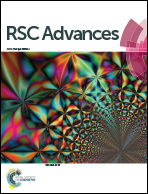Synergistic effect in bimetallic copper–silver (CuxAg) nanoparticles enhances silicon conversion in Rochow reaction†
Abstract
The oleylamine thermal reduction process was employed to prepare bimetallic copper–silver (CuxAg (0 ≤ x ≤ 50)) nanoparticles, such as Cu, Cu50Ag, Cu20Ag, Cu10Ag, Cu5Ag, CuAg, CuAg2, and Ag, by using Cu(CH3COO)2 and AgNO3 as the precursors. The samples were characterized by X-ray diffraction, transmission electron microscopy, thermogravimetric analysis, and X-ray photoelectron spectroscopy. The CuxAg hybrid nanostructure showed good particle dispersion, and Cu and Ag metals were well mixed. The catalytic properties of these bimetallic CuxAg nanoparticles as model catalysts for the Rochow reaction were explored. Compared to monometallic Cu and Ag nanoparticles, bimetallic CuxAg nanoparticles resulted in a much higher silicon conversion, which is attributed to the synergistic electronic effect between Cu and Ag metals. For example, the Cu atom was observed to have a lower electron density in the CuxAg bimetallic nanoparticle than that in monometallic Cu nanoparticles, which enhanced the formation of methylchlorosilanes on the silicon surface with chloromethane, demonstrating the significance of the CuxAg bimetallic catalysts in catalytic reactions during organosilane synthesis. The insights gained in this study should be conducive to the design of good Cu-based catalysts for the Rochow reaction.


 Please wait while we load your content...
Please wait while we load your content...